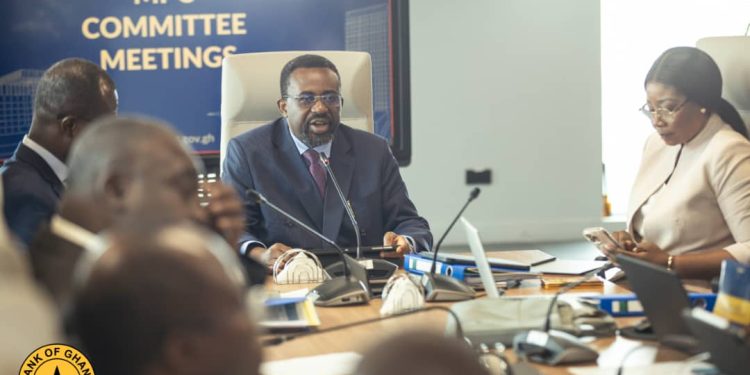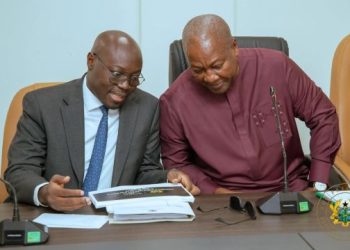Ghana has recorded a combined provisional trade surplus and current account surplus of $9 billion in the first half of 2025, marking one of the most remarkable external sector performances in recent economic history.
Governor of the Bank of Ghana (BoG), Dr. Johnson Asiama, announced the figures Monday during the opening session of the 125th Meeting of the Bank’s Monetary Policy Committee (MPC). The trade surplus came in at a provisional $5.6 billion—more than four times higher than the same period in 2024—while the current account surplus widened to $3.4 billion.
According to the Governor, the bumper external performance has significantly strengthened Ghana’s international reserves and contributed to a strong appreciation of the local currency.
“The cedi appreciated strongly by 42.6% against the US dollar, 30.3% against the British pound, and 25.6% against the euro,” Dr. Asiama said.
These historic gains, he noted, were driven by increased export receipts—especially from gold and cocoa—strong remittance inflows, and renewed investor confidence following Ghana’s successful performance reviews under the International Monetary Fund (IMF) Extended Credit Facility programme.
Disinflation and growth on track
On the domestic front, Ghana’s macroeconomic recovery continues to build momentum. Inflation has decelerated steadily for six consecutive months, reaching 13.7% in June 2025—the lowest since December 2021.
“This reflects disciplined monetary and fiscal policy management as well as the impact of the cedi’s appreciation on imported inflation,” Dr. Asiama explained.
Provisional GDP data for the first quarter of 2025 showed real economic growth of 5.3%, largely driven by strong performances in agriculture and services.
Non-oil GDP outpaced the overall figure, growing by 6.8%, while the Bank’s Composite Index of Economic Activity rose by 4.4% in May 2025, buoyed by increased consumption, higher trade volumes, cement sales, and a rebound in tourism.
Banking sector remains stable despite high NPLs
Ghana’s banking sector remains broadly resilient, with key performance indicators trending in the right direction.
The capital adequacy ratio (CAR), excluding regulatory reliefs, improved to 18.2% as of June 2025, suggesting a well-capitalised sector.
Liquidity and profitability metrics have also shown improvement.
However, the sector is not without challenges.
“The non-performing loans (NPL) ratio remains elevated at 23.1%, requiring continued supervisory vigilance,” Dr. Asiama cautioned.
Fiscal consolidation paying off
Recent fiscal data from the 2025 Mid-Year Budget Review painted a promising picture of fiscal consolidation.
The government posted a primary surplus of 1.1% of GDP in the first half of 2025, significantly above the target of 0.4%.
The overall fiscal deficit also narrowed to 0.7% of GDP, and actual expenditures were 14.3% below the budget.
More remarkably, Ghana reduced its public debt stock by 15.6% during the first half of the year, lowering the debt-to-GDP ratio to 43.8%.
This rare achievement points to a strengthening debt sustainability trajectory.
“These outcomes signal a credible path to debt sustainability and macroeconomic stability,” the BoG Governor said.
Cautious optimism: Risks ahead
While the macroeconomic outlook appears positive, the Governor struck a note of caution, highlighting several downside risks that could test the durability of the gains made.
“We must remain alert to the potential resurgence of exchange rate volatility, rising crude oil prices, and the inflationary impact of certain taxes announced in the mid-year budget review,” Dr. Asiama warned.
He emphasised the importance of anchoring inflation expectations, maintaining credible policy direction, and ensuring continued coordination between fiscal and monetary authorities.
“Colleagues, as we commence our deliberations, the question before us is whether the current macroeconomic configuration warrants a recalibration of our monetary policy stance,” the Governor posed to the MPC members.
Global headwinds could impact Ghana’s outlook
Dr. Asiama also gave an overview of the evolving global economic landscape.
He noted that global growth is moderating, with forecasts projecting a slowdown from 3.3% in 2024 to 2.8% in 2025, due to elevated interest rates, tighter financial conditions, and geopolitical tensions.
“Although a recent ceasefire in the Middle East has helped stabilise oil prices, global risks remain elevated,” he noted, adding that the fragile disinflation path and lingering trade tensions continue to present significant uncertainty for emerging markets like Ghana.
Balancing act for the monetary policy committee
As the MPC begins its deliberations, the Governor emphasised that its mandate remains clear:
“We must maintain price stability while enabling conditions for inclusive and sustainable growth.”
Given Ghana’s improving external buffers, anchored inflation expectations, and growing market confidence, the decision ahead for the MPC will be how to balance support for recovery with the preservation of macroeconomic gains.
“We encourage staff and MPC members to maintain a strong focus on forward-looking risks, policy trade-offs, and the need to provide credible guidance to the market,” Dr. Asiama concluded.
The outcome of the MPC’s policy rate decision is expected in the coming days, with financial markets and investors keenly watching for signals that could shape monetary policy direction in the second half of 2025.











